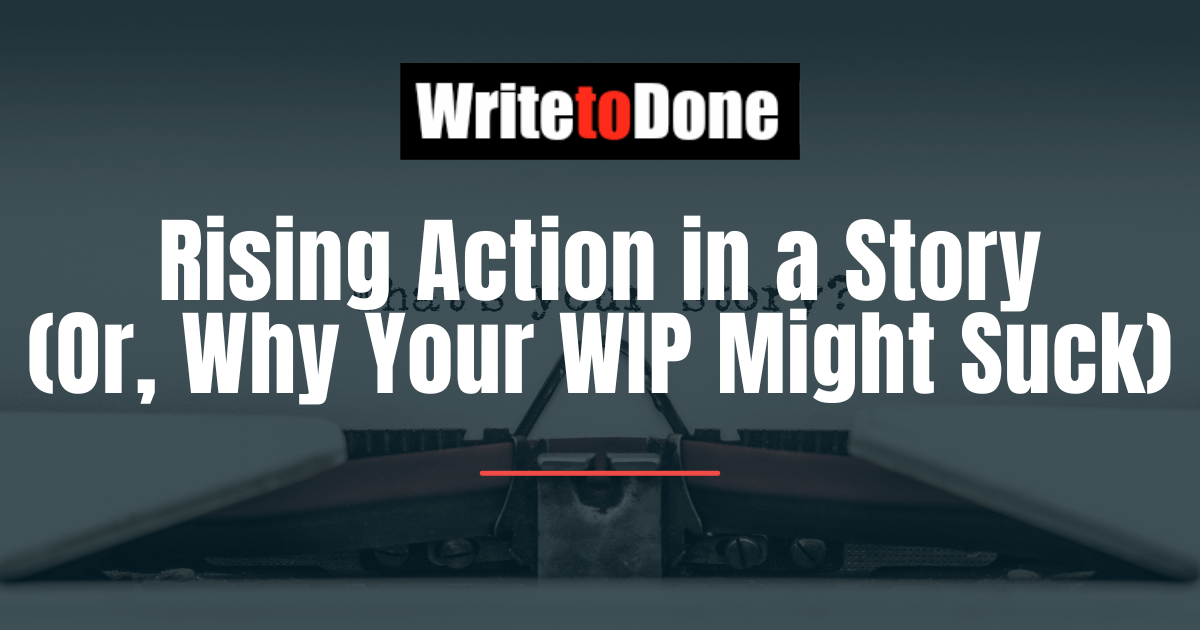Have you ever told somebody that you started a book but you just couldn’t get into it? Have you ever picked up a book and struggled through the first page, the first chapter, even the first half, only to stop reading entirely?
You may even have a bookshelf dedicated to books that you just never finished.
It might not be because you’re a bad reader. In fact, if you’re a writer, there’s a good chance you’re a great reader. The probable reason for all those books on that shelf, unread, is because those particular books lacked one key factor.
Chances are high that they each lacked rising action.
Rising action is a crucial part to any great story and a big factor in determining whether a reader will keep reading until the final sentence.
If you don’t have rising action in your book, you probably don’t have a great book. However, rising action can easily be learned and applied to your writing, whether fiction or nonfiction.
Just as learning to write takes time and practice, learning how to incorporate rising action takes time and practice. Don’t be discouraged if you feel overwhelmed at first. Like all things, it just takes work. You can learn the art of rising action and incorporate it into every page of your writing if you dedicate the time and attention necessary.
TABLE OF CONTENTS
- What Is Rising Action in a Story?
- What Is the Job of Rising Action?
- What to Include in Your Rising Action?
- Parting Tips

1. What Is Rising Action in a Story?
Rising action starts as close to page one, sentence one, as possible and uses tension to lead to action. That action then rises until the climax.
Think of rising action as preparing to serve a big dinner.
The action starts off slow as you determine who likes to eat what and you plan out the menu. You write out a grocery list. Next, you go to the store to purchase all the groceries you need. But whether you created a list or not, chances are you forget something. You already purchased the groceries and returned home. The guests are coming at seven o’clock.
This brings tension to your day.
Should you go back to the store and purchase the missing ingredient to ensure everything turns out? Or should you forget it and stay home and cook?
You wonder if you will meet your goal of providing a wonderful meal for your guests on time.
The action continues to rise as you decide what to cook first. You start putting ingredients together. You try to turn the oven on but it won’t start.
You run across the street to your neighbor’s house to see if you can borrow their oven. They are not home, but they have an open door policy, so you find the spare key and let yourself in.
At this point it is already three in the afternoon and you’re well behind schedule.
You get a phone call but don’t answer because you’re already too far behind. The caller leaves a voicemail. It’s your great-aunt you never hear from and she says you need to call back as soon as possible.
You decide to call back as you return to the store to purchase your missing ingredients. But on the way, someone skips the stop sign and you’re involved in a minor car crash.
Your aunt calls you a second time and this time you answer. She tells you that the guests arriving at your house tonight are not who they appear to be and that someone is after you.
Before you can ask any questions, the call goes dead.
In this example, every plot point increases the tension and as a result, raises the action.
2. What Is the Job of Rising Action?
The job of rising action is to take the reader from the first page to the last page through a riveting series of events.
If you don’t layer action into your story and incorporate it into your scenes, you will likely lose the reader.
Your job as a writer is to grab the reader’s attention and keep it until the end. Rising action helps ensure you do just that.
It’s important to remember that the type of rising action you use will depend on the genre you are writing. Rising action for a romance will look quite a bit different than rising action for a thriller.
Rising action for a children’s book will look different than rising action for a middle grade book or a young adult book.
Tip: When deciding what type of rising action to include in your story, read widely in the genre you write. This will help you understand the trends of rising action and also teach you what’s been overdone. Reading widely in your genre can also inspire ideas for how to incorporate rising action in a fresh way.
Remember, the core reason to incorporate rising action is to maintain your grip on the reader. A story is a story because there is tension and tention results in action.
Rising action will also help instill empathy for your protagonist in the heart of your reader. If you skip rising action and dump your reader right into the middle of the climax, there will not be an understanding for your protagonist. It’s crucial to establish an empathy for your protagonist on the part of your reader. The more invested your reader is in your characters, the more invested they will be in your story.
Including the appropriate amount of rising action will help draw in your reader, help them invest in your characters, and create a spellbinding experience until the last page.
3. What to Include in the Rising Action
What to include in your rising action is dependent on your specific story as well as the characters.
If your story is a thriller, the rising action will be much more obvious and even include quite a bit of literal action sequences. You may have fight scenes, an escape, a crash, a kidnapping, a rescue, etc., all toward the beginning of your novel.
If you’re writing nonfiction on how to start a business, your rising action will look quite a bit different. You might include your own experiences of starting from the ground up, and how things went from bad to worse until you finally found a breakthrough. This action fits the genre of the book you are writing.
As you decide what to include in your rising action, ask:
- What is at stake for my protagonist (nonfiction has a protagonist as well, whether you, the reader, or in biography/autobiography/memoir, the person the book is about)?
- What is the goal?
- What would hold the protagonist back from this goal?
- What does my protagonist need to do to achieve the goal/quest/journey?
- What could go wrong?
Here are some examples of stories with great rising action you can learn from:
In the Harry Potter series, Harry discovers he has some special abilities at the zoo. Eventually he makes it to Hogwarts and discovers he is actually a very important person with a quest in front of him. The action rises throughout book one, as well as throughout the entire series, until his quest is complete.
In the Lord of the Rings series, Frodo discovers that the Shire is not safe. The action rises throughout The Fellowship of the Ring, and throughout the series, until Frodo completes the quest and destroys the ring.
In The Hunger Games, the action rises as Katniss volunteers herself as tribute in place of her sister. The action continues to rise as she’s taken from her home in District 12 and transported to the Capitol, then to the arena, and fights for her life.
In The Four Winds, the action rises as Elsa is plunged into a completely new life, one she did not expect. The action continues to rise as she has to discover how to survive the Dust Bowl, her broken marriage, and the expectations of her family, all while feeling unloved. The action continues to rise until she takes possession of her life and proactively pursues what is necessary for the survival of herself and her family.
In Kindred, the action rises as Dana is transported back and forth through time with little to no warning The action continues to rise as she realizes what is at stake and what she must do to save herself and those she cares about.
Remember that rising action needs to be layered in as empathy is built on behalf of your protagonist.
Rising action is not the climax of your story
Imagine if The Fellowship of the Ring had started with Frodo throwing the ring into the fire.
There wouldn’t have been any story.
There wouldn’t have been any empathy.
The rising action throughout The Fellowship of the Ring, and the entire series, built slowly (hence the term rising action) in order to end with the reader invested in the character and satisfied with the ending.
If you want to write a compelling ending, it is absolutely crucial to preface it with compelling, rising action.
Character arc is directly tied to rising action. A well-rounded character grows over time. This brings credibility to the character. The more human characters appear, the more credibility they have.
If Harry had defeated He-Who-Must-Not-Be-Named in book one, his character would not be nearly as nuanced.
Parting Tips
As you begin incorporating rising action into your story, fiction or nonfiction, ask yourself how the rising action can reveal the character of your protagonist.
What characteristics need to be brought out of the character and how can the rising action be an aid?
What characteristics need to be hidden in your character for the time being and how can you use the rising action to keep the secret?
What characteristics can the action of other characters reveal about your protagonist?
Remember, not all rising action needs to be actual action scenes. Action and intention go hand-in-hand. Plot and character go hand-in-hand.
When used appropriately, each factors into a well-designed plot that will keep your reader turning pages.
Used well, rising action will point to the climax of your plot as well as the climax of your character arc, reveal your character for who they really are, and satisfy your reader.
















